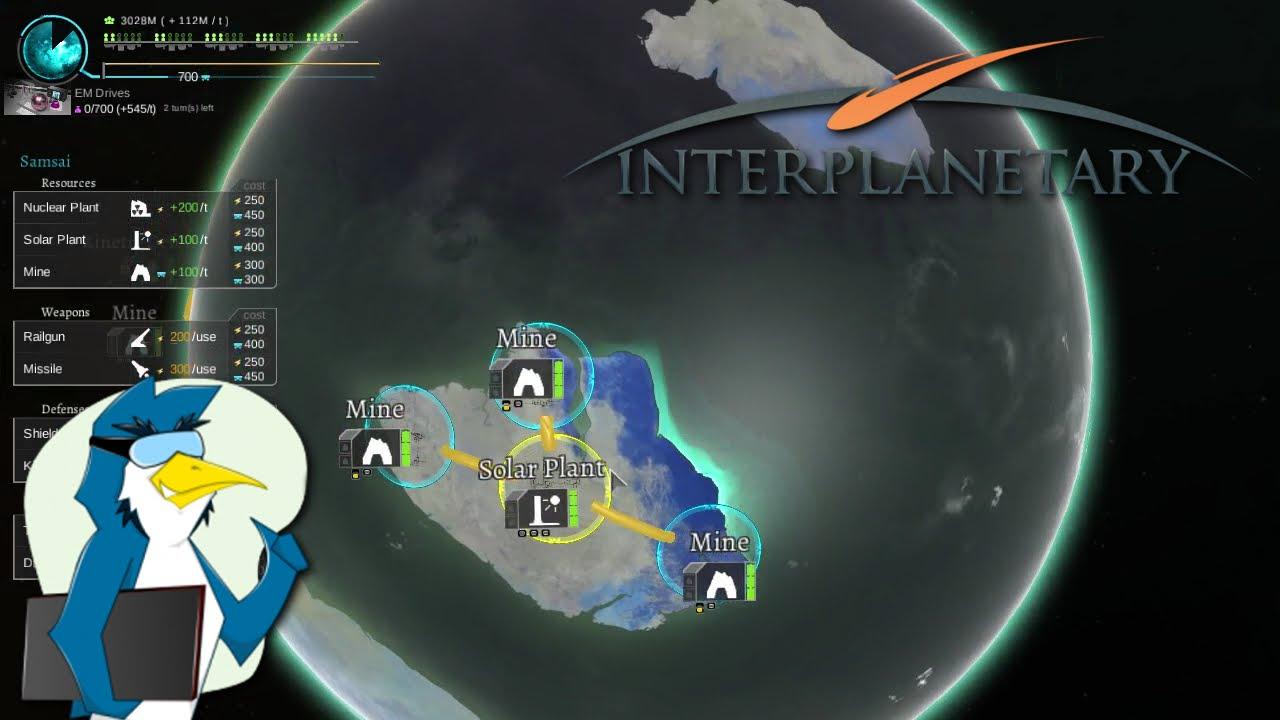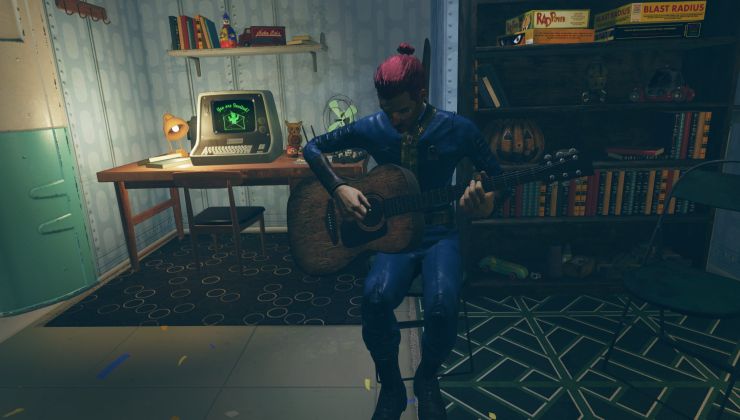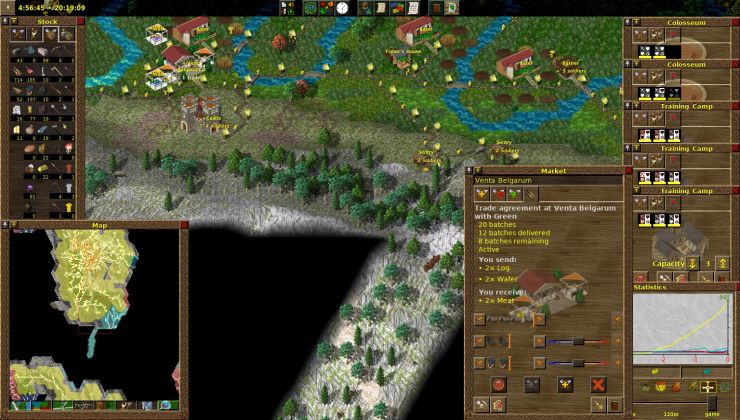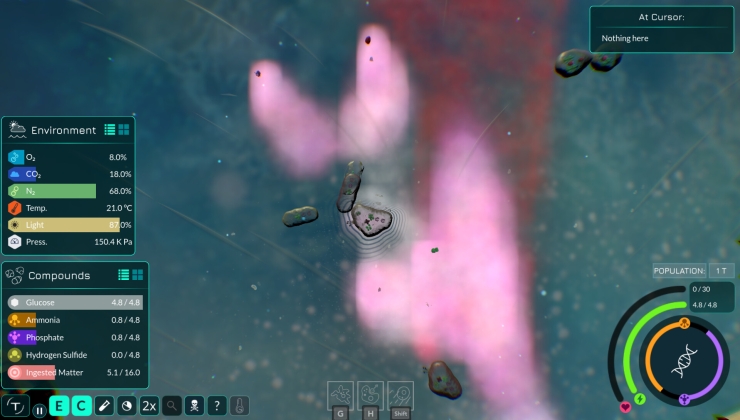So this game has been sitting on my todo list for a while. I delayed it due to bugs in the Early Access version and after that I had plenty of new material to cover. But I think it's time to go back and see where this ended up. Let's go blow up some planets!
Interplanetary is an turn-based artillery strategy game developed by Team Jolly Roger in which you must wage war on other planets in the same solar system. You won't be doing any ground invasions though and instead you must point missiles, rail guns and even asteroids towards the hostile planets to take out their cities. Naturally, the other planets are also quite eager to point their nukes at your cities, so you must also protect your own citizens.
Disclosure: I was sent a Steam key for this game during Early Access phase.

This game has a quite unique concept that I don't think I've seen before. Usually games like this have ships and troops you can move around and attempt to conquer the enemy planets or bomb them to dust from orbit. But here you instead need to build missile systems, lasers and rail guns on your planet and fire them, while also taking gravitational forces of other planetary bodies into account. It's sort of like those artillery games where you must destroy the other tanks or whatever, but instead of puny little tanks you are firing at cities from a long range.
A big part of the game is actually planning where to build your structures. You don't have any units that move around and everything is based on the static buildings. Their placement is very important because you want to make sure you can fire your weapons properly and protect your resource buildings from enemy fire. For example, the laser weaponry needs direct line of sight to be able to hit enemies. Missiles and rail guns can curve their shots using gravitational pull so they can fire indirectly, making them easier to place onto your planet.
Interplanetary has two types of resources. First there is the electricity which is produced by either solar or nuclear power plants. Solar power uses no extra resources but is not as effective. Then there are the planetary resources aka ores. To get them you need to build mines around your planet. Electricity is used to power your buildings and ore to build more structures or repair existing ones. The resources aren't infinite though and due to the extremely expensive interplanetary war they will start to run out fairly quickly. You need to plan carefully how you use them or you might find yourself on a planet mined dry of all of its raw materials. There are some upgrades to buildings that you will probably want to invest in to increase the global material yield.
The game has three types of normal weapons at your disposal. You have cheap rail guns that are very inaccurate but they have a large blast radius thanks to the projectiles fragmenting in the atmosphere. The second weapon type is the missiles. These are guided and can be pointed at set targets for more focused damage. The final weapon type is the laser which is a direct and very easy to aim weapon but it's area of effect is very limited. In addition to these you have two super-weapons which you will unlock at the end of the tech tree. They are the asteroid diversion installation and the solar laser. Asteroid diversion is fairly self-explanatory, you direct asteroids at other planets and make them go boom. They deal massive area of effect damage. The solar laser on the other hand works like the laser but it does a lot more damage and is practically unstoppable.
You also have two types of defensive buildings that you can set up to protect your buildings from enemy fire. They are the kinetic defense systems which simply try to destroy projectiles launched at you and shields which are more reliable but also more expensive and cannot block rail gun shots.
One of the important gameplay mechanics is the intelligence system. When you start the game you are extremely blind and all of the enemy buildings are completely hidden from you. If you build telescopic arrays you can begin to gain intel on the enemy planets and over time make the enemy buildings visible to you. This is important because you will often want to target specific targets instead of firing blindly at a planet and hoping you hit something. You can also generate counter-intelligence to protect your own buildings from being detected by the enemies. This is a very important thing to do because ignoring intelligence will make you very vulnerable and the enemies can quickly target your cities and completely wipe you out.
At first the game might look a bit complex but it's actually pretty simple when you think about it. The game mechanics are pretty easy to learn but of course mastery will take some time, especially when you try to learn how to hit the planets you are aiming for. The game does have an extensive text-tutorial built-in that will explain all of the game mechanics and you can get up and running fairly quickly. After 30 minutes I had learned mostly everything about the game and I decided to ignore the tutorial entirely.
Graphically Interplanetary looks quite good. It's not really a game in which pretty pretty graphics are important but the planets are nice to look at. The UI isn't maybe the greatest thing ever, especially when you upgrade or repair buildings, but it too gets the job done. The game also performs well and you can run it with fairly weak hardware. I did have some framedrops on my R7 370 but only when I was in the late game with a lot of stuff being built on the planets. Most of the time the game ran at 60 FPS.
Some AMD users might want to be aware of the fact that Catalyst (at least 15.7) might not work with the game. For me it would crash immediately after trying to start a match. However, if you use the open source drivers the game will run flawlessly and perform quite well. On Nvidia the game will work fine with the proprietary drivers.
Overall I think Interplanetary deserves my recommendations. It's a unique mix of artillery gameplay and planetary strategy that works well. It has a simple idea and it executes it well. The price might be a slight turn-off for some people but I think you should at least keep an eye out for it.
Interplanetary is an turn-based artillery strategy game developed by Team Jolly Roger in which you must wage war on other planets in the same solar system. You won't be doing any ground invasions though and instead you must point missiles, rail guns and even asteroids towards the hostile planets to take out their cities. Naturally, the other planets are also quite eager to point their nukes at your cities, so you must also protect your own citizens.
Disclosure: I was sent a Steam key for this game during Early Access phase.

YouTube videos require cookies, you must accept their cookies to view. View cookie preferences.
Direct Link
Direct Link
This game has a quite unique concept that I don't think I've seen before. Usually games like this have ships and troops you can move around and attempt to conquer the enemy planets or bomb them to dust from orbit. But here you instead need to build missile systems, lasers and rail guns on your planet and fire them, while also taking gravitational forces of other planetary bodies into account. It's sort of like those artillery games where you must destroy the other tanks or whatever, but instead of puny little tanks you are firing at cities from a long range.
A big part of the game is actually planning where to build your structures. You don't have any units that move around and everything is based on the static buildings. Their placement is very important because you want to make sure you can fire your weapons properly and protect your resource buildings from enemy fire. For example, the laser weaponry needs direct line of sight to be able to hit enemies. Missiles and rail guns can curve their shots using gravitational pull so they can fire indirectly, making them easier to place onto your planet.
Interplanetary has two types of resources. First there is the electricity which is produced by either solar or nuclear power plants. Solar power uses no extra resources but is not as effective. Then there are the planetary resources aka ores. To get them you need to build mines around your planet. Electricity is used to power your buildings and ore to build more structures or repair existing ones. The resources aren't infinite though and due to the extremely expensive interplanetary war they will start to run out fairly quickly. You need to plan carefully how you use them or you might find yourself on a planet mined dry of all of its raw materials. There are some upgrades to buildings that you will probably want to invest in to increase the global material yield.
The game has three types of normal weapons at your disposal. You have cheap rail guns that are very inaccurate but they have a large blast radius thanks to the projectiles fragmenting in the atmosphere. The second weapon type is the missiles. These are guided and can be pointed at set targets for more focused damage. The final weapon type is the laser which is a direct and very easy to aim weapon but it's area of effect is very limited. In addition to these you have two super-weapons which you will unlock at the end of the tech tree. They are the asteroid diversion installation and the solar laser. Asteroid diversion is fairly self-explanatory, you direct asteroids at other planets and make them go boom. They deal massive area of effect damage. The solar laser on the other hand works like the laser but it does a lot more damage and is practically unstoppable.
You also have two types of defensive buildings that you can set up to protect your buildings from enemy fire. They are the kinetic defense systems which simply try to destroy projectiles launched at you and shields which are more reliable but also more expensive and cannot block rail gun shots.
One of the important gameplay mechanics is the intelligence system. When you start the game you are extremely blind and all of the enemy buildings are completely hidden from you. If you build telescopic arrays you can begin to gain intel on the enemy planets and over time make the enemy buildings visible to you. This is important because you will often want to target specific targets instead of firing blindly at a planet and hoping you hit something. You can also generate counter-intelligence to protect your own buildings from being detected by the enemies. This is a very important thing to do because ignoring intelligence will make you very vulnerable and the enemies can quickly target your cities and completely wipe you out.
At first the game might look a bit complex but it's actually pretty simple when you think about it. The game mechanics are pretty easy to learn but of course mastery will take some time, especially when you try to learn how to hit the planets you are aiming for. The game does have an extensive text-tutorial built-in that will explain all of the game mechanics and you can get up and running fairly quickly. After 30 minutes I had learned mostly everything about the game and I decided to ignore the tutorial entirely.
Graphically Interplanetary looks quite good. It's not really a game in which pretty pretty graphics are important but the planets are nice to look at. The UI isn't maybe the greatest thing ever, especially when you upgrade or repair buildings, but it too gets the job done. The game also performs well and you can run it with fairly weak hardware. I did have some framedrops on my R7 370 but only when I was in the late game with a lot of stuff being built on the planets. Most of the time the game ran at 60 FPS.
Some AMD users might want to be aware of the fact that Catalyst (at least 15.7) might not work with the game. For me it would crash immediately after trying to start a match. However, if you use the open source drivers the game will run flawlessly and perform quite well. On Nvidia the game will work fine with the proprietary drivers.
Overall I think Interplanetary deserves my recommendations. It's a unique mix of artillery gameplay and planetary strategy that works well. It has a simple idea and it executes it well. The price might be a slight turn-off for some people but I think you should at least keep an eye out for it.
Some you may have missed, popular articles from the last month:
All posts need to follow our rules. Please hit the Report Flag icon on any post that breaks the rules or contains illegal / harmful content. Readers can also email us for any issues or concerns.
It's currently in the [Humble Weekly Bundle](https://www.humblebundle.com/weekly) so one can currently get it for much cheaper! :)
0 Likes
Myself and Samsai played it online together, he won obviously!
I think it's pretty decent, and quite a unique strategy game.
Also, rematch needed Samsai.
I think it's pretty decent, and quite a unique strategy game.
Also, rematch needed Samsai.
0 Likes





 How to setup OpenMW for modern Morrowind on Linux / SteamOS and Steam Deck
How to setup OpenMW for modern Morrowind on Linux / SteamOS and Steam Deck How to install Hollow Knight: Silksong mods on Linux, SteamOS and Steam Deck
How to install Hollow Knight: Silksong mods on Linux, SteamOS and Steam Deck